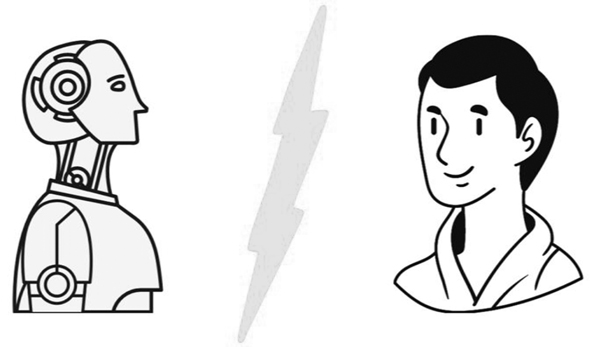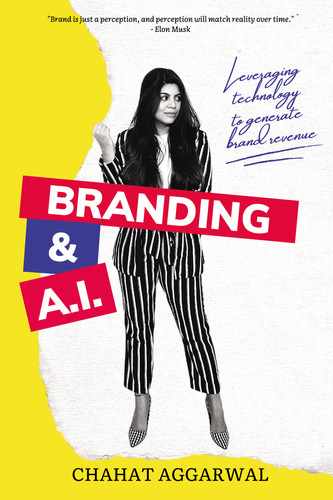Overview
With the rise of artificial intelligence (AI), predominant questions arise on the coexistence of human intelligence and AI. Whether it is a competition or a collaboration? This chapter focuses on conceptualizing the answers for the same with the best available information and examples in the present time. The rise of this technology is aimed to decrease the amount of time and effort exerted on mundane tasks that can easily be taken up by a machine. So, now people are equipped with more time to focus on thinking, developing creative and innovative solutions and actions beyond the reach of AI.
A parallel is drawn to the fact that this allows humans to expend more energy on quality and strategic tasks, facilitating us to be more human. It also acknowledges that the natural tendency of humans to be flawed also implies that their creations are imperatively imperfect. When it comes to branding and marketing, though AI has widened its scope and perspectives through personalized services, it still requires human creativity and qualities to take it forward. The chapter further discusses how scientific research must focus on developing AI applications that could integrate with human intelligence to enhance productivity within the broad constraints of privacy and judgments.
Change might be constant, but how much does that affect us? Accepting change is of utmost significance in this age and day when the world is taken by storm with marvels of technology and the miraculous creations of the human brain that manifest itself in every field, whether arts, science, literature. And, the more our curiosity for the unknown is satiated, the more the challenge is to cope with an upgraded environment where everything is made convenient to the point that human efforts and talent face the innate threat of being obsolete and a thing of the past.
The same concern that the great comedian and actor and above all, the genius, Charlie Chaplin, depicted through his masterpiece, Hard Times. When machines dominate humans, throwing them out of the picture, they created them in the first place. The scenario is daunting, and, probably 10 years before, it might have felt like a mere possible scenario that may or may not happen. However, the plight is different now. Progress is on its way to conquer the zenith of excellence, and we are left with the omnipresent debate of human intelligence versus AI. Will AI take over the realm of humans rendering human efforts futile and obsolete? Is the promising field of machine learning a wolf in the disguise of a lamb waiting to tear us down?
AI versus human intelligence—is it a competition or a collaboration?

According to Forrester, “Every industry will be dramatically disrupted by artificial intelligence (A.I.) applications very soon if they haven’t already been. In 2020, businesses that use A.I. to uncover new insights will take $1.2 trillion each year from competitors that don’t.”
AI, no doubt, has a notable dominance in multiple tasks, mainly when it appears to be about monotonous judgments:
Execution speed: Although a doctor can perform a diagnosis in about 10 minutes, the AI can simultaneously execute a million.
Unbiased: AI involves none to less biased opinions on the decision-making manner.
Operation: AI does not require as many pauses in their task because of overload as humans.
Accuracy: Preciseness of the output increases.
Does this mean that a technology that is the human mind’s brainchild will disrupt the creator with its supremacy?
However, there is still a catch to it. Because no matter what, it is not easy for the creation to overtake its creator. Because there is a human filter that all the human hand products go through, the traces of which imperatively require the human touch are flawed and imperfect. Sometimes, imperfection even adds to the advantage.
As discussed in the previous chapter, the innate flaws always ensure a better space for improvement and innovation because of the human potential to change and adapt to the changing surroundings and needs.
Also, individual qualities and skills come with the patented trademark, Human. The qualities that cannot be mastered by machines. Machines can be organized and perfect and work with high-efficiency levels; however, the realm of creativity and innovation will always be dominated by humans, no matter how much machine learning progresses. Because mimicking will never equal what is real and raw. And, natural and raw are what help to strike a chord. It is similar to what Plato told about poetry being thrice removed from the truth. And, in this case, human creativity trumps the machine’s perfection. To put it into a better set of words helps to strike a balance between them. A certain level of harmony lets both go hand in hand without disrupting or exploiting the other.
The rise of artificial intelligence is raising the premium on tasks that only humans can do: it is freeing workers from drudgery and allowing them to spend time on more strategic and valuable business activities. Instead of forcing people to spend time and effort on tasks that we find hard but computers find easy, we will be rewarded for doing what humans do best—and artificial intelligence will help make us all more human.
—Timo Elliott, Innovation Evangelist, SAP
What Is the Difference?
Nature
Human intelligence is all about adjusting to the environment using a mixture of several cognitive processes. Simultaneously, the AI platform is focused on designing machines that can mimic human behavior.
Memory
People use content consciousness and thinking whereas, AI is applying built-in instructions produced by specialists.
Learning
Human intelligence learns and reacts to the irregularities they encounter in life and the reactions or interactions, resulting in millions of functions overall in their lives. However, AI is limited or developed for particular jobs only, and its applicability on other tasks may not be readily attainable.
Having AI will be a boon to humanity. AI may enable us to solve global climate change. It can also lead to a rise in the pace of economic growth and level of production. Let us have a look at the impact of AI in our world:
1. AI’s most evident impact is the rise of automation across a wide range of sectors, transforming it from manual to digital—more efficiently. Jobs that required repetition, data consumption, or vast data interpretation and management are now achieved by an AI—making it quicker and cost-effective.
2. As AI and machine learning execute, humans perform manual tasks, welcome new opportunities, build new industries, and innovative approaches to life and business. For example, digital engineering is an upcoming profession that came into the picture from the fast development of technology. So, although manual tasks may be gone, new jobs and occupations will be emerging along with the AI.
3. AI can unlock tons of businesses opportunities and improve productivity and participation within the organization. This, in turn, can increase demand for products and services and drive an economic growth model that delivers and enhances the quality of living.
4. As AI takes away some of the mundane tasks out of our hands, people now have more time to focus on thinking, developing creative and innovative solutions, and actions beyond the reach of AI and are squarely in the domain of human intelligence.
There is always the question of exploration versus exploitation when we talk about AI versus human. Exploring involves discovering newer realms of knowledge, looking into the unknown, and then using the tool of creativity to form better definitions. On the other hand, exploration is a complete refinement of the available resources, drawing out the last bit of what is available to make the best use. It is hard to say whether exploitation or exploration is the ideal way to harness the resources. Depending on the circumstances, we must balance both exploitations for creative optimization of resources and exploration for innovative ideas. The former is done best by AI, and the latter is done by humans, again underscoring the importance of a necessary balance, which is the ideal framework for both.
They are coming to the debate about AI versus human intelligence; recent AI progress mimics human intelligence even more closely now. However, machines still have a long way to match what human brains are capable of doing. Our ability to process and implement the knowledge we acquire, with a sense of logic, reasoning, and experience, makes us unique. While machines can mimic human behavior to some extent, their expertise to make a rational decision may fall behind in comparison to us. AI-powered machines lack “common sense” and are heavily dependent on information and events. AI systems are clueless in understanding “action” and “consequences,” hence cannot understand or operate on the holistic human approach. “With knowledge comes power, and with power comes great responsibility.”
AI has made our tasks easier in some ways. But, it is far away from being perfect. There have been some significant failures that have raised questions about AI being a part of our lives:
1. While under computer control, Uber self-driving autonomous car killed a pedestrian.
2. Innocent people were incorrectly classified as possible criminals as AI-enabled facial recognition tools became biased toward colored skin tones.
3. IBM’s Watson AI advised unsafe and inaccurate cancer treatments.
4. In short, it is not AI versus human that works, but AI and human, clubbed together, working in tune with each other, thereby drawing the best and most fruitful results. Through proper collaboration and strategy, both can work to enhance each other’s strengths.
Even when it comes to branding and marketing, though AI has widened its scope and perspectives through personalized services, it still requires human creativity and qualities to take it forward. Because specific attributes like hard work, passion, determination, etc. cannot be comprehended by machines, machines can always sharpen those qualities, thereby leading to efficiency.

The right perspective would be to AI’s positive attributes with human intelligence to explain the significant gap separating human intelligence and AI. Scientific research should focus on developing AI applications that could integrate with human intelligence to enhance productivity within the broad constraints of privacy and judgments. If we will build a collaborative environment for both, it would surely open up new opportunities for many in numerous different fields.
1. According to Forrester, “Every industry will be dramatically disrupted by artificial intelligence (A.I.) applications very soon if they haven’t already been. In 2020, businesses that use A.I. to uncover new insights will take $1.2 trillion each year from competitors that don’t.”
2. AI provides execution speed, nonbiased results, efficient operation, and accuracy.
3. Individual qualities and skills come with the patented trademark, Human. The qualities that cannot be mastered by machines. Machines can be organized and perfect and work with high-efficiency levels; however, the realm of creativity and innovation will always be dominated by humans.
4. Human intelligence is all about adjusting to the environment using a mixture of several cognitive processes. Simultaneously, the AI platform is focused on designing machines that can mimic human behavior.
5. People use content consciousness and thinking, whereas AI is applying built-in instructions produced by specialists.
6. As AI and machine learning execute, humans perform manual tasks, welcome new opportunities, build new industries, and innovative approaches to life and business.
7. AI-powered machines lack “common sense” and are heavily dependent on information and events. AI systems are clueless in understanding “action” and “consequences,” hence cannot understand or operate on the holistic human approach. “With knowledge comes power, and with power comes great responsibility.”
8. AI has made our tasks easier in some ways. But, it is far away from being perfect. There have been some significant failures that have raised questions about AI being a part of our lives.
9. The right perspective would be to AI’s positive attributes with human intelligence to explain the significant gap separating human intelligence and AI.
